Factors Impacting the Health of Aboriginal and Torres Strait Islanders
VerifiedAdded on 2023/01/19
|11
|3114
|85
AI Summary
This article discusses the factors that impact the health and well-being of Aboriginal and Torres Strait Islanders, including education, racism, housing, and employment. It explores how these factors contribute to health disparities and offers insights into improving health outcomes for this population.
Contribute Materials
Your contribution can guide someone’s learning journey. Share your
documents today.
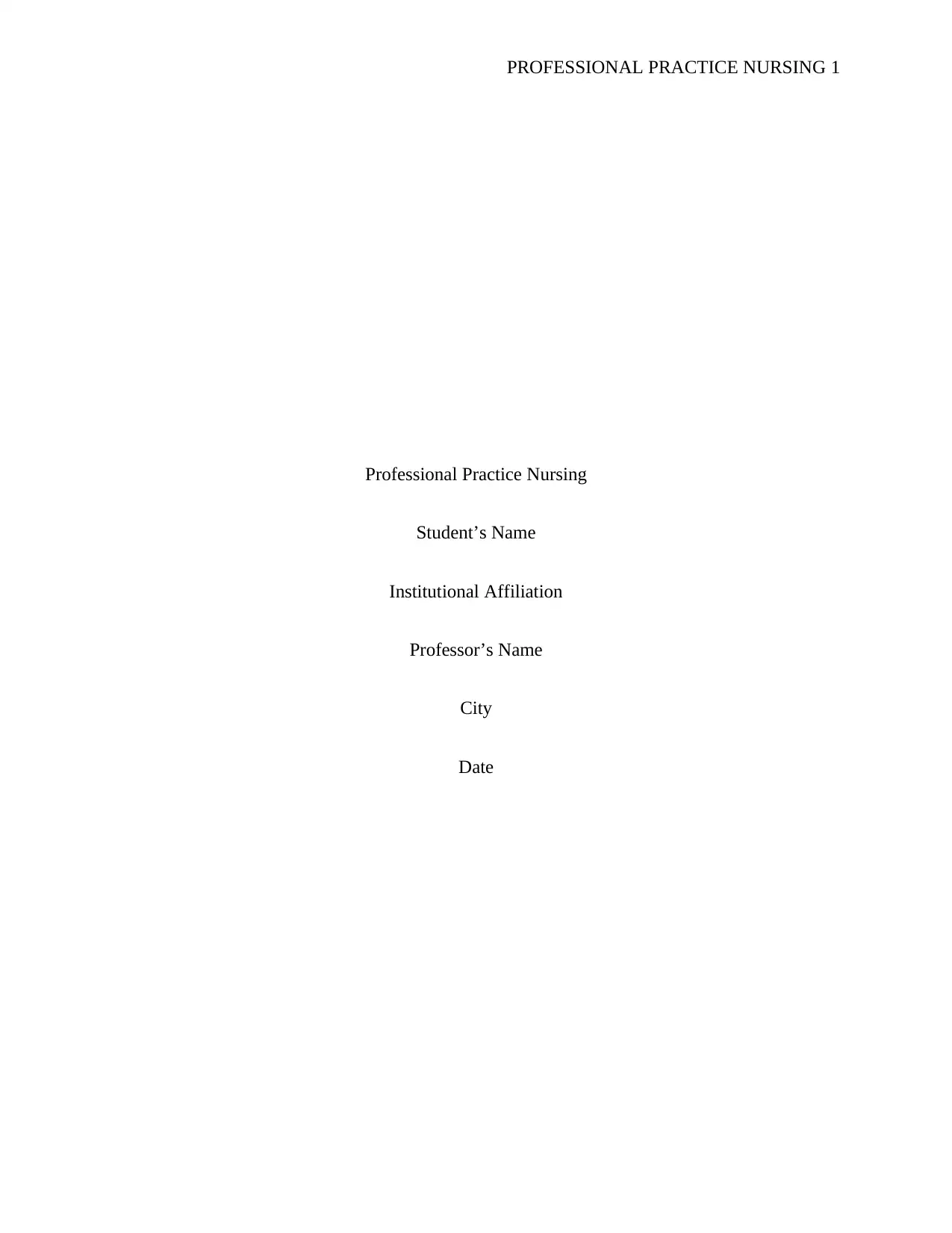
PROFESSIONAL PRACTICE NURSING 1
Professional Practice Nursing
Student’s Name
Institutional Affiliation
Professor’s Name
City
Date
Professional Practice Nursing
Student’s Name
Institutional Affiliation
Professor’s Name
City
Date
Secure Best Marks with AI Grader
Need help grading? Try our AI Grader for instant feedback on your assignments.
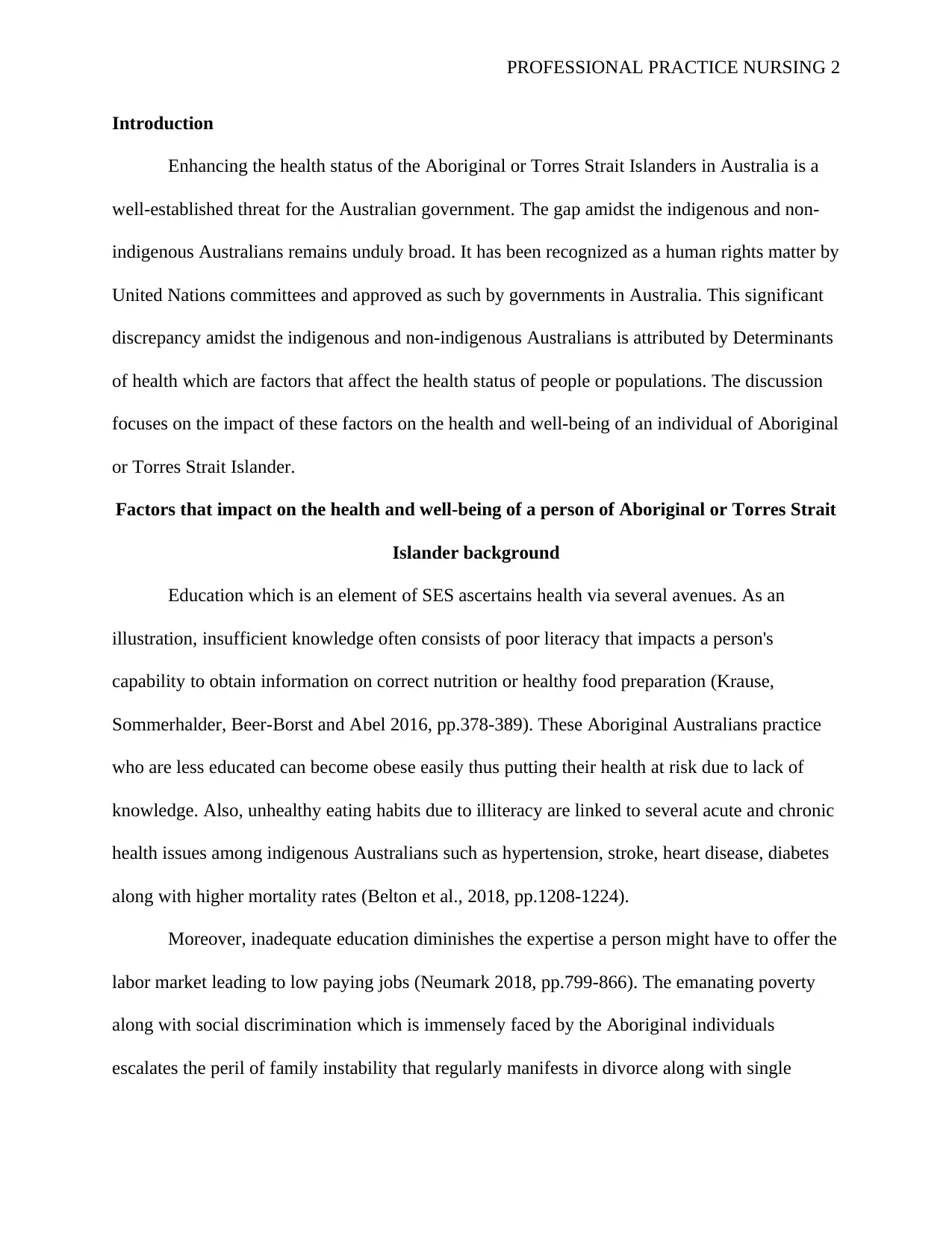
PROFESSIONAL PRACTICE NURSING 2
Introduction
Enhancing the health status of the Aboriginal or Torres Strait Islanders in Australia is a
well-established threat for the Australian government. The gap amidst the indigenous and non-
indigenous Australians remains unduly broad. It has been recognized as a human rights matter by
United Nations committees and approved as such by governments in Australia. This significant
discrepancy amidst the indigenous and non-indigenous Australians is attributed by Determinants
of health which are factors that affect the health status of people or populations. The discussion
focuses on the impact of these factors on the health and well-being of an individual of Aboriginal
or Torres Strait Islander.
Factors that impact on the health and well-being of a person of Aboriginal or Torres Strait
Islander background
Education which is an element of SES ascertains health via several avenues. As an
illustration, insufficient knowledge often consists of poor literacy that impacts a person's
capability to obtain information on correct nutrition or healthy food preparation (Krause,
Sommerhalder, Beer-Borst and Abel 2016, pp.378-389). These Aboriginal Australians practice
who are less educated can become obese easily thus putting their health at risk due to lack of
knowledge. Also, unhealthy eating habits due to illiteracy are linked to several acute and chronic
health issues among indigenous Australians such as hypertension, stroke, heart disease, diabetes
along with higher mortality rates (Belton et al., 2018, pp.1208-1224).
Moreover, inadequate education diminishes the expertise a person might have to offer the
labor market leading to low paying jobs (Neumark 2018, pp.799-866). The emanating poverty
along with social discrimination which is immensely faced by the Aboriginal individuals
escalates the peril of family instability that regularly manifests in divorce along with single
Introduction
Enhancing the health status of the Aboriginal or Torres Strait Islanders in Australia is a
well-established threat for the Australian government. The gap amidst the indigenous and non-
indigenous Australians remains unduly broad. It has been recognized as a human rights matter by
United Nations committees and approved as such by governments in Australia. This significant
discrepancy amidst the indigenous and non-indigenous Australians is attributed by Determinants
of health which are factors that affect the health status of people or populations. The discussion
focuses on the impact of these factors on the health and well-being of an individual of Aboriginal
or Torres Strait Islander.
Factors that impact on the health and well-being of a person of Aboriginal or Torres Strait
Islander background
Education which is an element of SES ascertains health via several avenues. As an
illustration, insufficient knowledge often consists of poor literacy that impacts a person's
capability to obtain information on correct nutrition or healthy food preparation (Krause,
Sommerhalder, Beer-Borst and Abel 2016, pp.378-389). These Aboriginal Australians practice
who are less educated can become obese easily thus putting their health at risk due to lack of
knowledge. Also, unhealthy eating habits due to illiteracy are linked to several acute and chronic
health issues among indigenous Australians such as hypertension, stroke, heart disease, diabetes
along with higher mortality rates (Belton et al., 2018, pp.1208-1224).
Moreover, inadequate education diminishes the expertise a person might have to offer the
labor market leading to low paying jobs (Neumark 2018, pp.799-866). The emanating poverty
along with social discrimination which is immensely faced by the Aboriginal individuals
escalates the peril of family instability that regularly manifests in divorce along with single
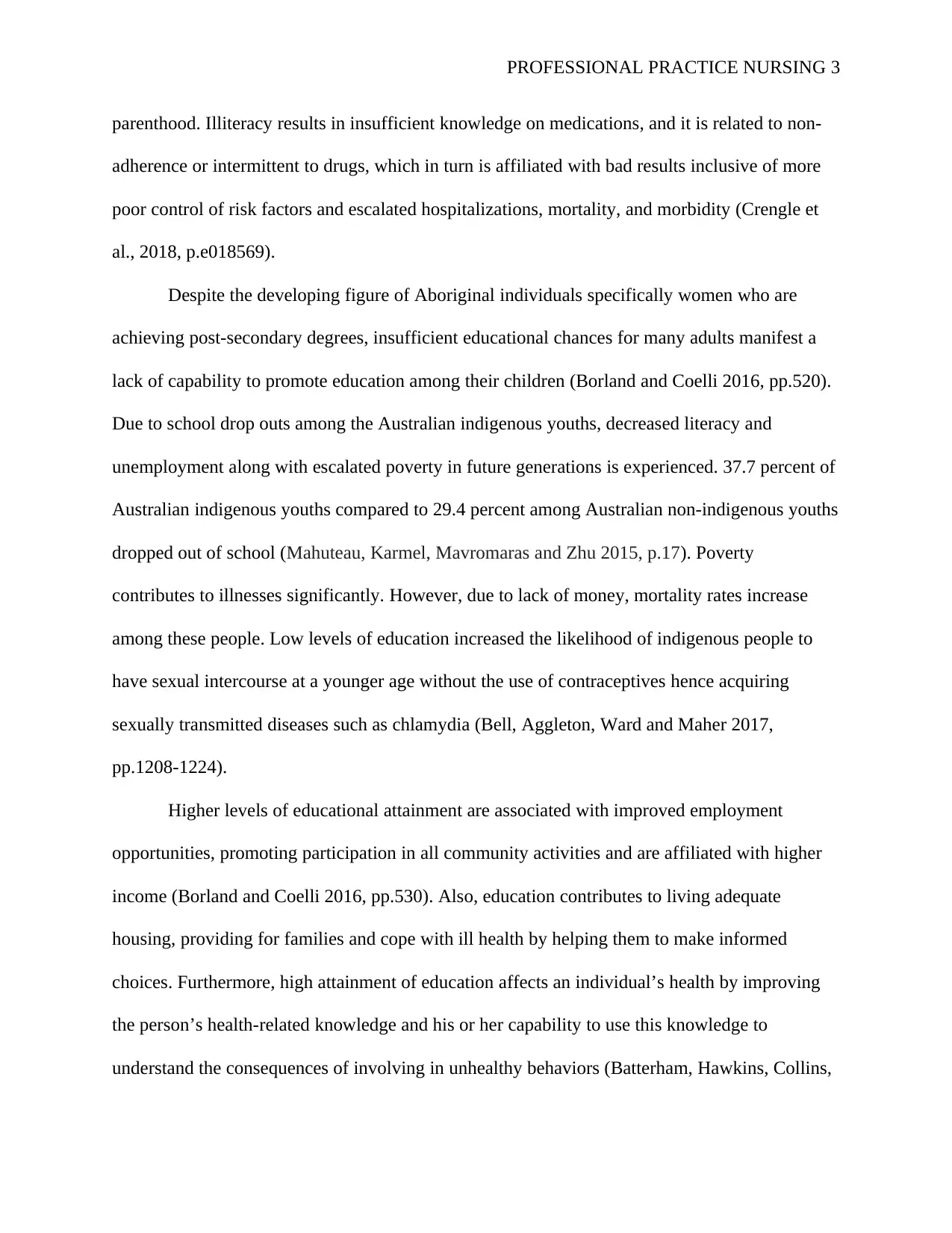
PROFESSIONAL PRACTICE NURSING 3
parenthood. Illiteracy results in insufficient knowledge on medications, and it is related to non-
adherence or intermittent to drugs, which in turn is affiliated with bad results inclusive of more
poor control of risk factors and escalated hospitalizations, mortality, and morbidity (Crengle et
al., 2018, p.e018569).
Despite the developing figure of Aboriginal individuals specifically women who are
achieving post-secondary degrees, insufficient educational chances for many adults manifest a
lack of capability to promote education among their children (Borland and Coelli 2016, pp.520).
Due to school drop outs among the Australian indigenous youths, decreased literacy and
unemployment along with escalated poverty in future generations is experienced. 37.7 percent of
Australian indigenous youths compared to 29.4 percent among Australian non-indigenous youths
dropped out of school (Mahuteau, Karmel, Mavromaras and Zhu 2015, p.17). Poverty
contributes to illnesses significantly. However, due to lack of money, mortality rates increase
among these people. Low levels of education increased the likelihood of indigenous people to
have sexual intercourse at a younger age without the use of contraceptives hence acquiring
sexually transmitted diseases such as chlamydia (Bell, Aggleton, Ward and Maher 2017,
pp.1208-1224).
Higher levels of educational attainment are associated with improved employment
opportunities, promoting participation in all community activities and are affiliated with higher
income (Borland and Coelli 2016, pp.530). Also, education contributes to living adequate
housing, providing for families and cope with ill health by helping them to make informed
choices. Furthermore, high attainment of education affects an individual’s health by improving
the person’s health-related knowledge and his or her capability to use this knowledge to
understand the consequences of involving in unhealthy behaviors (Batterham, Hawkins, Collins,
parenthood. Illiteracy results in insufficient knowledge on medications, and it is related to non-
adherence or intermittent to drugs, which in turn is affiliated with bad results inclusive of more
poor control of risk factors and escalated hospitalizations, mortality, and morbidity (Crengle et
al., 2018, p.e018569).
Despite the developing figure of Aboriginal individuals specifically women who are
achieving post-secondary degrees, insufficient educational chances for many adults manifest a
lack of capability to promote education among their children (Borland and Coelli 2016, pp.520).
Due to school drop outs among the Australian indigenous youths, decreased literacy and
unemployment along with escalated poverty in future generations is experienced. 37.7 percent of
Australian indigenous youths compared to 29.4 percent among Australian non-indigenous youths
dropped out of school (Mahuteau, Karmel, Mavromaras and Zhu 2015, p.17). Poverty
contributes to illnesses significantly. However, due to lack of money, mortality rates increase
among these people. Low levels of education increased the likelihood of indigenous people to
have sexual intercourse at a younger age without the use of contraceptives hence acquiring
sexually transmitted diseases such as chlamydia (Bell, Aggleton, Ward and Maher 2017,
pp.1208-1224).
Higher levels of educational attainment are associated with improved employment
opportunities, promoting participation in all community activities and are affiliated with higher
income (Borland and Coelli 2016, pp.530). Also, education contributes to living adequate
housing, providing for families and cope with ill health by helping them to make informed
choices. Furthermore, high attainment of education affects an individual’s health by improving
the person’s health-related knowledge and his or her capability to use this knowledge to
understand the consequences of involving in unhealthy behaviors (Batterham, Hawkins, Collins,
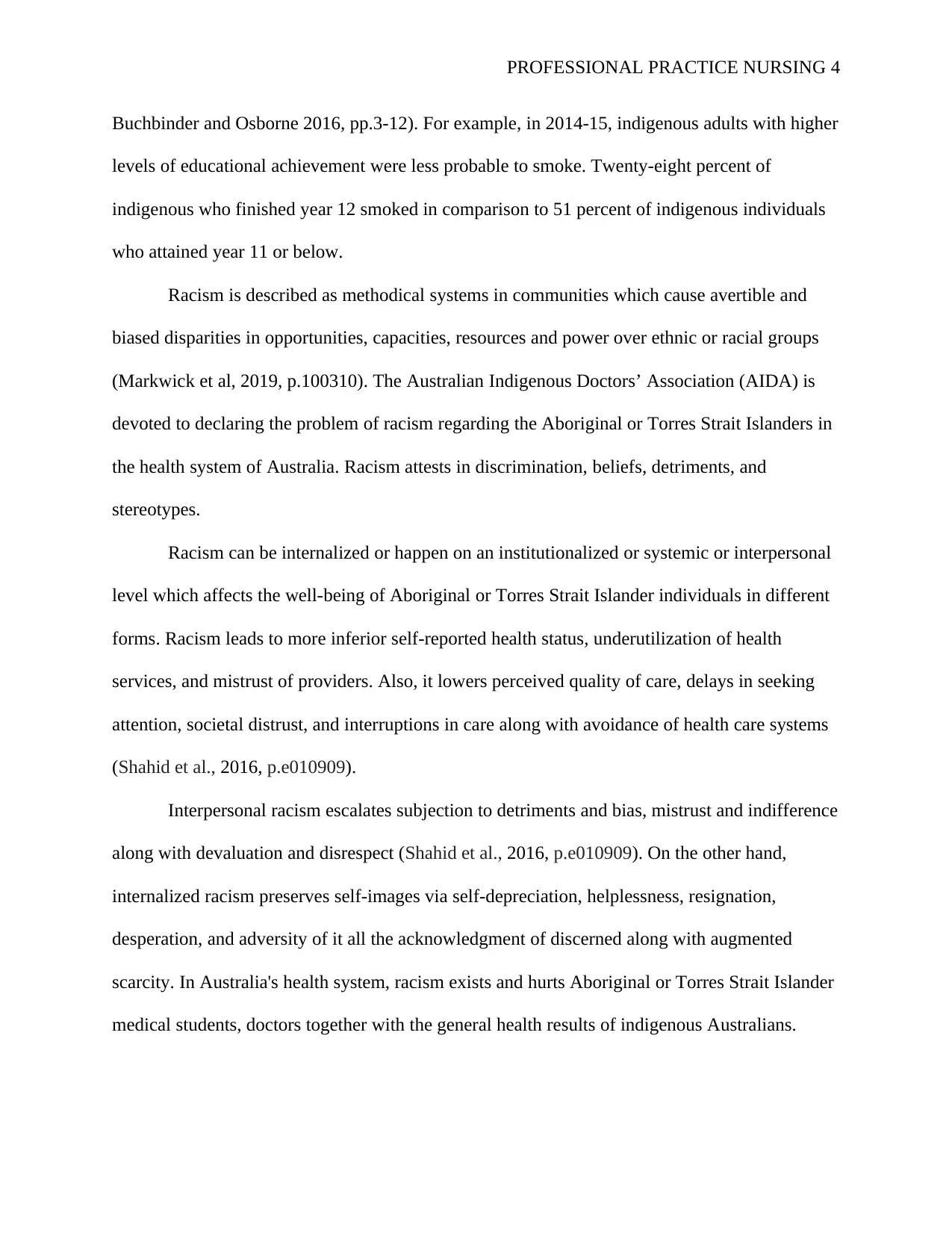
PROFESSIONAL PRACTICE NURSING 4
Buchbinder and Osborne 2016, pp.3-12). For example, in 2014-15, indigenous adults with higher
levels of educational achievement were less probable to smoke. Twenty-eight percent of
indigenous who finished year 12 smoked in comparison to 51 percent of indigenous individuals
who attained year 11 or below.
Racism is described as methodical systems in communities which cause avertible and
biased disparities in opportunities, capacities, resources and power over ethnic or racial groups
(Markwick et al, 2019, p.100310). The Australian Indigenous Doctors’ Association (AIDA) is
devoted to declaring the problem of racism regarding the Aboriginal or Torres Strait Islanders in
the health system of Australia. Racism attests in discrimination, beliefs, detriments, and
stereotypes.
Racism can be internalized or happen on an institutionalized or systemic or interpersonal
level which affects the well-being of Aboriginal or Torres Strait Islander individuals in different
forms. Racism leads to more inferior self-reported health status, underutilization of health
services, and mistrust of providers. Also, it lowers perceived quality of care, delays in seeking
attention, societal distrust, and interruptions in care along with avoidance of health care systems
(Shahid et al., 2016, p.e010909).
Interpersonal racism escalates subjection to detriments and bias, mistrust and indifference
along with devaluation and disrespect (Shahid et al., 2016, p.e010909). On the other hand,
internalized racism preserves self-images via self-depreciation, helplessness, resignation,
desperation, and adversity of it all the acknowledgment of discerned along with augmented
scarcity. In Australia's health system, racism exists and hurts Aboriginal or Torres Strait Islander
medical students, doctors together with the general health results of indigenous Australians.
Buchbinder and Osborne 2016, pp.3-12). For example, in 2014-15, indigenous adults with higher
levels of educational achievement were less probable to smoke. Twenty-eight percent of
indigenous who finished year 12 smoked in comparison to 51 percent of indigenous individuals
who attained year 11 or below.
Racism is described as methodical systems in communities which cause avertible and
biased disparities in opportunities, capacities, resources and power over ethnic or racial groups
(Markwick et al, 2019, p.100310). The Australian Indigenous Doctors’ Association (AIDA) is
devoted to declaring the problem of racism regarding the Aboriginal or Torres Strait Islanders in
the health system of Australia. Racism attests in discrimination, beliefs, detriments, and
stereotypes.
Racism can be internalized or happen on an institutionalized or systemic or interpersonal
level which affects the well-being of Aboriginal or Torres Strait Islander individuals in different
forms. Racism leads to more inferior self-reported health status, underutilization of health
services, and mistrust of providers. Also, it lowers perceived quality of care, delays in seeking
attention, societal distrust, and interruptions in care along with avoidance of health care systems
(Shahid et al., 2016, p.e010909).
Interpersonal racism escalates subjection to detriments and bias, mistrust and indifference
along with devaluation and disrespect (Shahid et al., 2016, p.e010909). On the other hand,
internalized racism preserves self-images via self-depreciation, helplessness, resignation,
desperation, and adversity of it all the acknowledgment of discerned along with augmented
scarcity. In Australia's health system, racism exists and hurts Aboriginal or Torres Strait Islander
medical students, doctors together with the general health results of indigenous Australians.
Secure Best Marks with AI Grader
Need help grading? Try our AI Grader for instant feedback on your assignments.
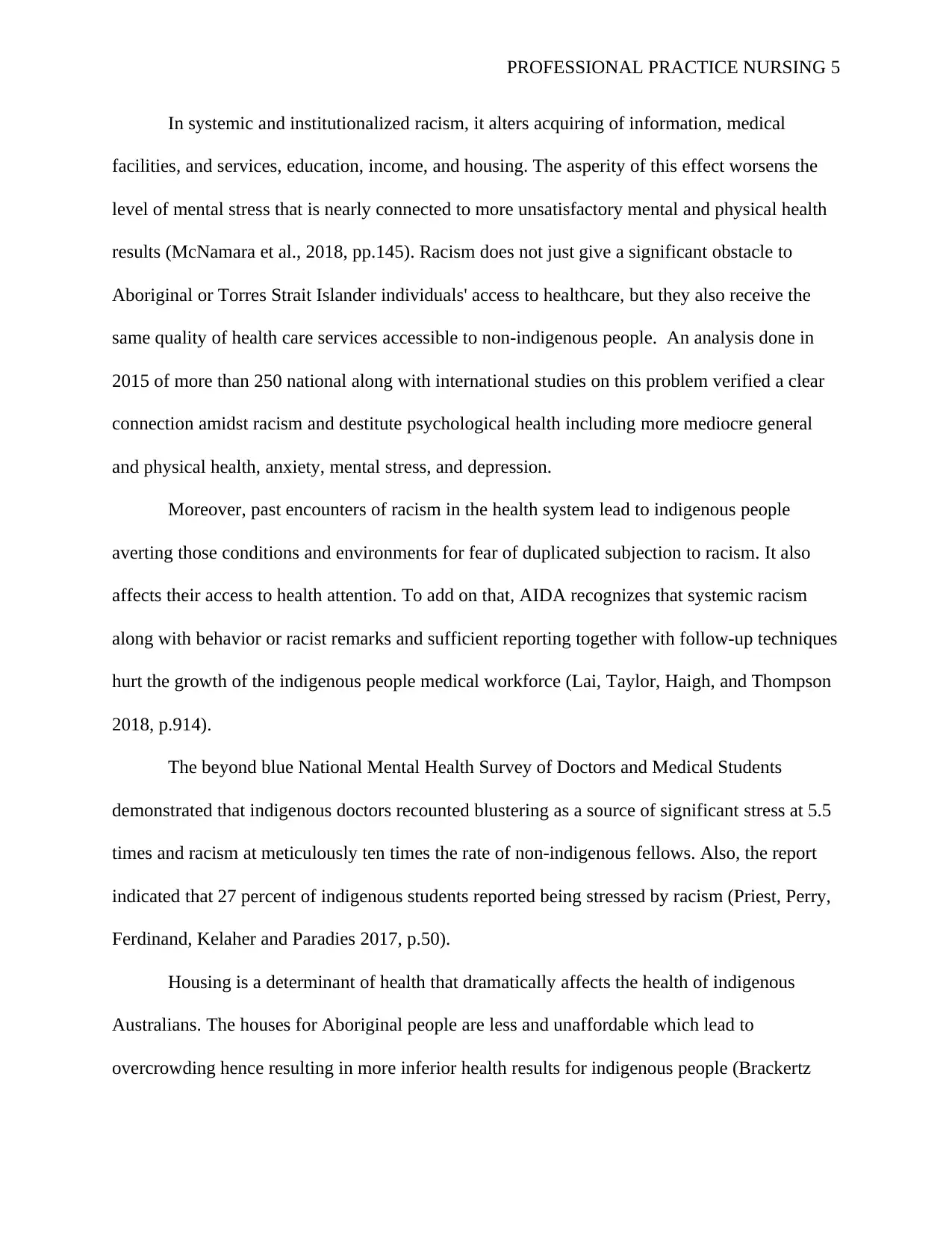
PROFESSIONAL PRACTICE NURSING 5
In systemic and institutionalized racism, it alters acquiring of information, medical
facilities, and services, education, income, and housing. The asperity of this effect worsens the
level of mental stress that is nearly connected to more unsatisfactory mental and physical health
results (McNamara et al., 2018, pp.145). Racism does not just give a significant obstacle to
Aboriginal or Torres Strait Islander individuals' access to healthcare, but they also receive the
same quality of health care services accessible to non-indigenous people. An analysis done in
2015 of more than 250 national along with international studies on this problem verified a clear
connection amidst racism and destitute psychological health including more mediocre general
and physical health, anxiety, mental stress, and depression.
Moreover, past encounters of racism in the health system lead to indigenous people
averting those conditions and environments for fear of duplicated subjection to racism. It also
affects their access to health attention. To add on that, AIDA recognizes that systemic racism
along with behavior or racist remarks and sufficient reporting together with follow-up techniques
hurt the growth of the indigenous people medical workforce (Lai, Taylor, Haigh, and Thompson
2018, p.914).
The beyond blue National Mental Health Survey of Doctors and Medical Students
demonstrated that indigenous doctors recounted blustering as a source of significant stress at 5.5
times and racism at meticulously ten times the rate of non-indigenous fellows. Also, the report
indicated that 27 percent of indigenous students reported being stressed by racism (Priest, Perry,
Ferdinand, Kelaher and Paradies 2017, p.50).
Housing is a determinant of health that dramatically affects the health of indigenous
Australians. The houses for Aboriginal people are less and unaffordable which lead to
overcrowding hence resulting in more inferior health results for indigenous people (Brackertz
In systemic and institutionalized racism, it alters acquiring of information, medical
facilities, and services, education, income, and housing. The asperity of this effect worsens the
level of mental stress that is nearly connected to more unsatisfactory mental and physical health
results (McNamara et al., 2018, pp.145). Racism does not just give a significant obstacle to
Aboriginal or Torres Strait Islander individuals' access to healthcare, but they also receive the
same quality of health care services accessible to non-indigenous people. An analysis done in
2015 of more than 250 national along with international studies on this problem verified a clear
connection amidst racism and destitute psychological health including more mediocre general
and physical health, anxiety, mental stress, and depression.
Moreover, past encounters of racism in the health system lead to indigenous people
averting those conditions and environments for fear of duplicated subjection to racism. It also
affects their access to health attention. To add on that, AIDA recognizes that systemic racism
along with behavior or racist remarks and sufficient reporting together with follow-up techniques
hurt the growth of the indigenous people medical workforce (Lai, Taylor, Haigh, and Thompson
2018, p.914).
The beyond blue National Mental Health Survey of Doctors and Medical Students
demonstrated that indigenous doctors recounted blustering as a source of significant stress at 5.5
times and racism at meticulously ten times the rate of non-indigenous fellows. Also, the report
indicated that 27 percent of indigenous students reported being stressed by racism (Priest, Perry,
Ferdinand, Kelaher and Paradies 2017, p.50).
Housing is a determinant of health that dramatically affects the health of indigenous
Australians. The houses for Aboriginal people are less and unaffordable which lead to
overcrowding hence resulting in more inferior health results for indigenous people (Brackertz
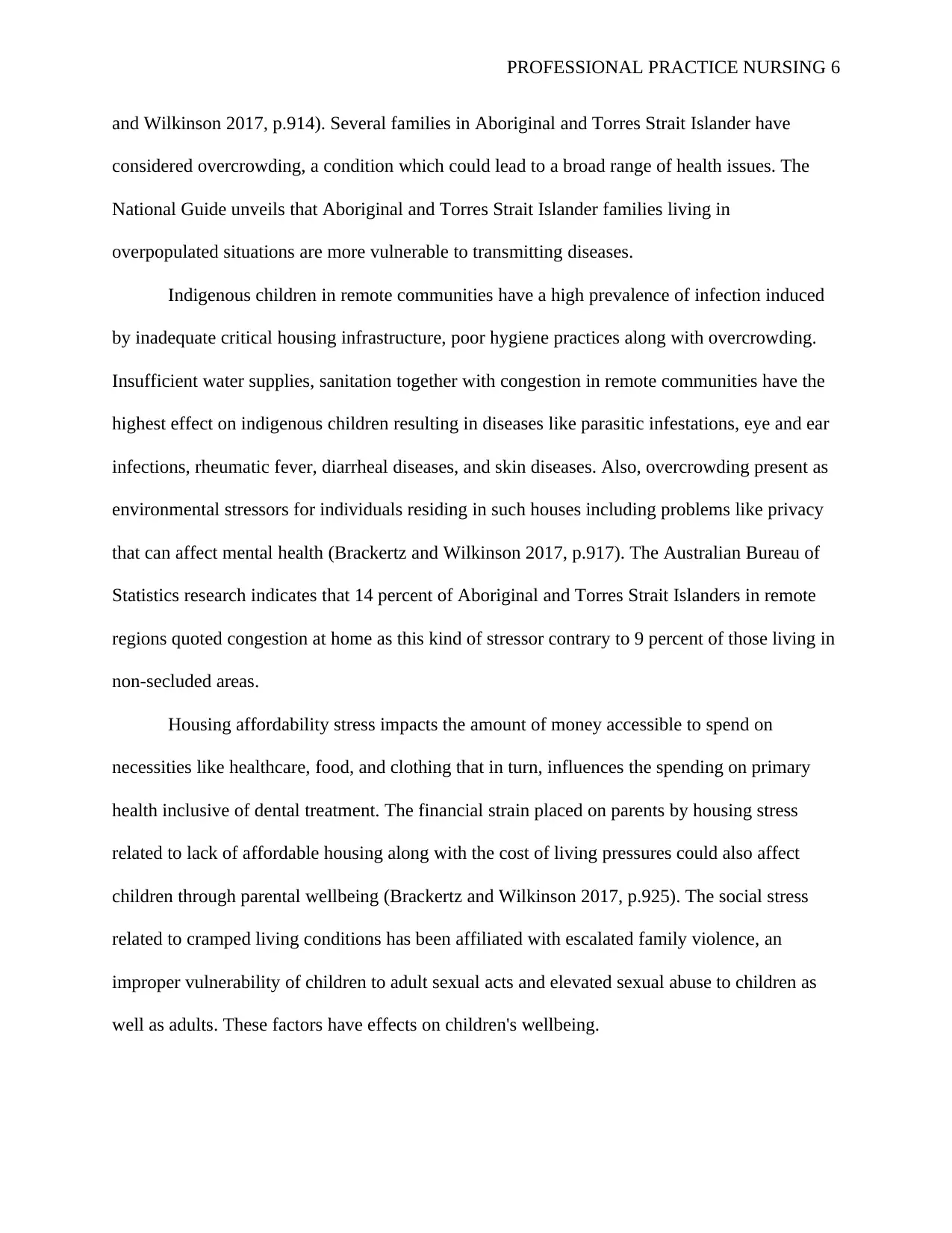
PROFESSIONAL PRACTICE NURSING 6
and Wilkinson 2017, p.914). Several families in Aboriginal and Torres Strait Islander have
considered overcrowding, a condition which could lead to a broad range of health issues. The
National Guide unveils that Aboriginal and Torres Strait Islander families living in
overpopulated situations are more vulnerable to transmitting diseases.
Indigenous children in remote communities have a high prevalence of infection induced
by inadequate critical housing infrastructure, poor hygiene practices along with overcrowding.
Insufficient water supplies, sanitation together with congestion in remote communities have the
highest effect on indigenous children resulting in diseases like parasitic infestations, eye and ear
infections, rheumatic fever, diarrheal diseases, and skin diseases. Also, overcrowding present as
environmental stressors for individuals residing in such houses including problems like privacy
that can affect mental health (Brackertz and Wilkinson 2017, p.917). The Australian Bureau of
Statistics research indicates that 14 percent of Aboriginal and Torres Strait Islanders in remote
regions quoted congestion at home as this kind of stressor contrary to 9 percent of those living in
non-secluded areas.
Housing affordability stress impacts the amount of money accessible to spend on
necessities like healthcare, food, and clothing that in turn, influences the spending on primary
health inclusive of dental treatment. The financial strain placed on parents by housing stress
related to lack of affordable housing along with the cost of living pressures could also affect
children through parental wellbeing (Brackertz and Wilkinson 2017, p.925). The social stress
related to cramped living conditions has been affiliated with escalated family violence, an
improper vulnerability of children to adult sexual acts and elevated sexual abuse to children as
well as adults. These factors have effects on children's wellbeing.
and Wilkinson 2017, p.914). Several families in Aboriginal and Torres Strait Islander have
considered overcrowding, a condition which could lead to a broad range of health issues. The
National Guide unveils that Aboriginal and Torres Strait Islander families living in
overpopulated situations are more vulnerable to transmitting diseases.
Indigenous children in remote communities have a high prevalence of infection induced
by inadequate critical housing infrastructure, poor hygiene practices along with overcrowding.
Insufficient water supplies, sanitation together with congestion in remote communities have the
highest effect on indigenous children resulting in diseases like parasitic infestations, eye and ear
infections, rheumatic fever, diarrheal diseases, and skin diseases. Also, overcrowding present as
environmental stressors for individuals residing in such houses including problems like privacy
that can affect mental health (Brackertz and Wilkinson 2017, p.917). The Australian Bureau of
Statistics research indicates that 14 percent of Aboriginal and Torres Strait Islanders in remote
regions quoted congestion at home as this kind of stressor contrary to 9 percent of those living in
non-secluded areas.
Housing affordability stress impacts the amount of money accessible to spend on
necessities like healthcare, food, and clothing that in turn, influences the spending on primary
health inclusive of dental treatment. The financial strain placed on parents by housing stress
related to lack of affordable housing along with the cost of living pressures could also affect
children through parental wellbeing (Brackertz and Wilkinson 2017, p.925). The social stress
related to cramped living conditions has been affiliated with escalated family violence, an
improper vulnerability of children to adult sexual acts and elevated sexual abuse to children as
well as adults. These factors have effects on children's wellbeing.
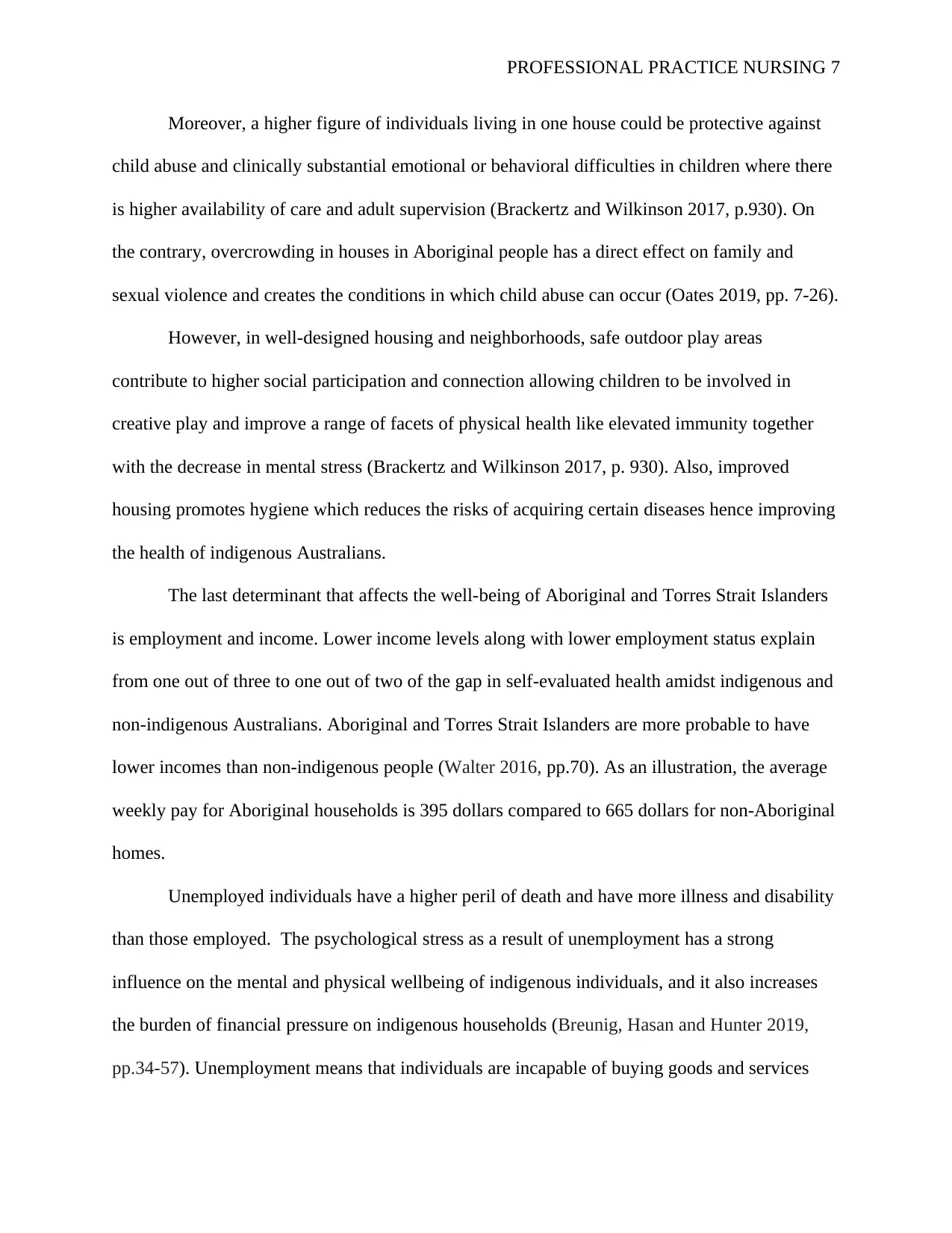
PROFESSIONAL PRACTICE NURSING 7
Moreover, a higher figure of individuals living in one house could be protective against
child abuse and clinically substantial emotional or behavioral difficulties in children where there
is higher availability of care and adult supervision (Brackertz and Wilkinson 2017, p.930). On
the contrary, overcrowding in houses in Aboriginal people has a direct effect on family and
sexual violence and creates the conditions in which child abuse can occur (Oates 2019, pp. 7-26).
However, in well-designed housing and neighborhoods, safe outdoor play areas
contribute to higher social participation and connection allowing children to be involved in
creative play and improve a range of facets of physical health like elevated immunity together
with the decrease in mental stress (Brackertz and Wilkinson 2017, p. 930). Also, improved
housing promotes hygiene which reduces the risks of acquiring certain diseases hence improving
the health of indigenous Australians.
The last determinant that affects the well-being of Aboriginal and Torres Strait Islanders
is employment and income. Lower income levels along with lower employment status explain
from one out of three to one out of two of the gap in self-evaluated health amidst indigenous and
non-indigenous Australians. Aboriginal and Torres Strait Islanders are more probable to have
lower incomes than non-indigenous people (Walter 2016, pp.70). As an illustration, the average
weekly pay for Aboriginal households is 395 dollars compared to 665 dollars for non-Aboriginal
homes.
Unemployed individuals have a higher peril of death and have more illness and disability
than those employed. The psychological stress as a result of unemployment has a strong
influence on the mental and physical wellbeing of indigenous individuals, and it also increases
the burden of financial pressure on indigenous households (Breunig, Hasan and Hunter 2019,
pp.34-57). Unemployment means that individuals are incapable of buying goods and services
Moreover, a higher figure of individuals living in one house could be protective against
child abuse and clinically substantial emotional or behavioral difficulties in children where there
is higher availability of care and adult supervision (Brackertz and Wilkinson 2017, p.930). On
the contrary, overcrowding in houses in Aboriginal people has a direct effect on family and
sexual violence and creates the conditions in which child abuse can occur (Oates 2019, pp. 7-26).
However, in well-designed housing and neighborhoods, safe outdoor play areas
contribute to higher social participation and connection allowing children to be involved in
creative play and improve a range of facets of physical health like elevated immunity together
with the decrease in mental stress (Brackertz and Wilkinson 2017, p. 930). Also, improved
housing promotes hygiene which reduces the risks of acquiring certain diseases hence improving
the health of indigenous Australians.
The last determinant that affects the well-being of Aboriginal and Torres Strait Islanders
is employment and income. Lower income levels along with lower employment status explain
from one out of three to one out of two of the gap in self-evaluated health amidst indigenous and
non-indigenous Australians. Aboriginal and Torres Strait Islanders are more probable to have
lower incomes than non-indigenous people (Walter 2016, pp.70). As an illustration, the average
weekly pay for Aboriginal households is 395 dollars compared to 665 dollars for non-Aboriginal
homes.
Unemployed individuals have a higher peril of death and have more illness and disability
than those employed. The psychological stress as a result of unemployment has a strong
influence on the mental and physical wellbeing of indigenous individuals, and it also increases
the burden of financial pressure on indigenous households (Breunig, Hasan and Hunter 2019,
pp.34-57). Unemployment means that individuals are incapable of buying goods and services
Paraphrase This Document
Need a fresh take? Get an instant paraphrase of this document with our AI Paraphraser

PROFESSIONAL PRACTICE NURSING 8
which can create health and it is detrimental psychological and social effects. Unemployment
and less income influence overweight and obesity. This is through insufficient physical exercise
and also poor diet since the Aboriginal people cannot afford to buy healthy foods. Unemployed
Aboriginal Australians tend to use illicit drugs as an excuse to forget the challenges they
encounter. The use of these drugs contributes to illnesses and injuries, several deaths, social
along with family disruptions, violence, and crime.
Employment has a secure connection to a position in the society and is always affiliated
with higher education and income levels. Besides enhancing the socioeconomic status, a higher
income enables for more top access to goods and services which offer health benefits like more
health care options, more excellent choice in healthy pursuits along with better food and housing
(Gould, Lim, and Mattes 2017, pp.853-866). Moreover, indigenous people with more social,
economic along with cultural benefits are more probable to involve in behaviors which foster
good health. For instance, indigenous Australians who were employed in 2014-15 were rarely
possible to smoke, lesser probable to use illegal substances and more probable to have sufficient
daily fruit uptake compared to unemployed indigenous people.
In conclusion, the determinants of health that impact the health of Aboriginals and Torres
Strait Islanders are education, racism and discrimination, housing along with employment and
income. Some of these factors are interrelated in that, high attainment of knowledge leads to a
better position in the community and increases the employment opportunities. Moreover,
employment and high levels of income lead to adequate housing among the indigenous
Australians hence improved health. There is a proof that attests to the fact that Aboriginal or
Torres Strait Islander individuals encounter racism of several kinds regularly and that such
exposure is detrimental to their health and well-being.
which can create health and it is detrimental psychological and social effects. Unemployment
and less income influence overweight and obesity. This is through insufficient physical exercise
and also poor diet since the Aboriginal people cannot afford to buy healthy foods. Unemployed
Aboriginal Australians tend to use illicit drugs as an excuse to forget the challenges they
encounter. The use of these drugs contributes to illnesses and injuries, several deaths, social
along with family disruptions, violence, and crime.
Employment has a secure connection to a position in the society and is always affiliated
with higher education and income levels. Besides enhancing the socioeconomic status, a higher
income enables for more top access to goods and services which offer health benefits like more
health care options, more excellent choice in healthy pursuits along with better food and housing
(Gould, Lim, and Mattes 2017, pp.853-866). Moreover, indigenous people with more social,
economic along with cultural benefits are more probable to involve in behaviors which foster
good health. For instance, indigenous Australians who were employed in 2014-15 were rarely
possible to smoke, lesser probable to use illegal substances and more probable to have sufficient
daily fruit uptake compared to unemployed indigenous people.
In conclusion, the determinants of health that impact the health of Aboriginals and Torres
Strait Islanders are education, racism and discrimination, housing along with employment and
income. Some of these factors are interrelated in that, high attainment of knowledge leads to a
better position in the community and increases the employment opportunities. Moreover,
employment and high levels of income lead to adequate housing among the indigenous
Australians hence improved health. There is a proof that attests to the fact that Aboriginal or
Torres Strait Islander individuals encounter racism of several kinds regularly and that such
exposure is detrimental to their health and well-being.
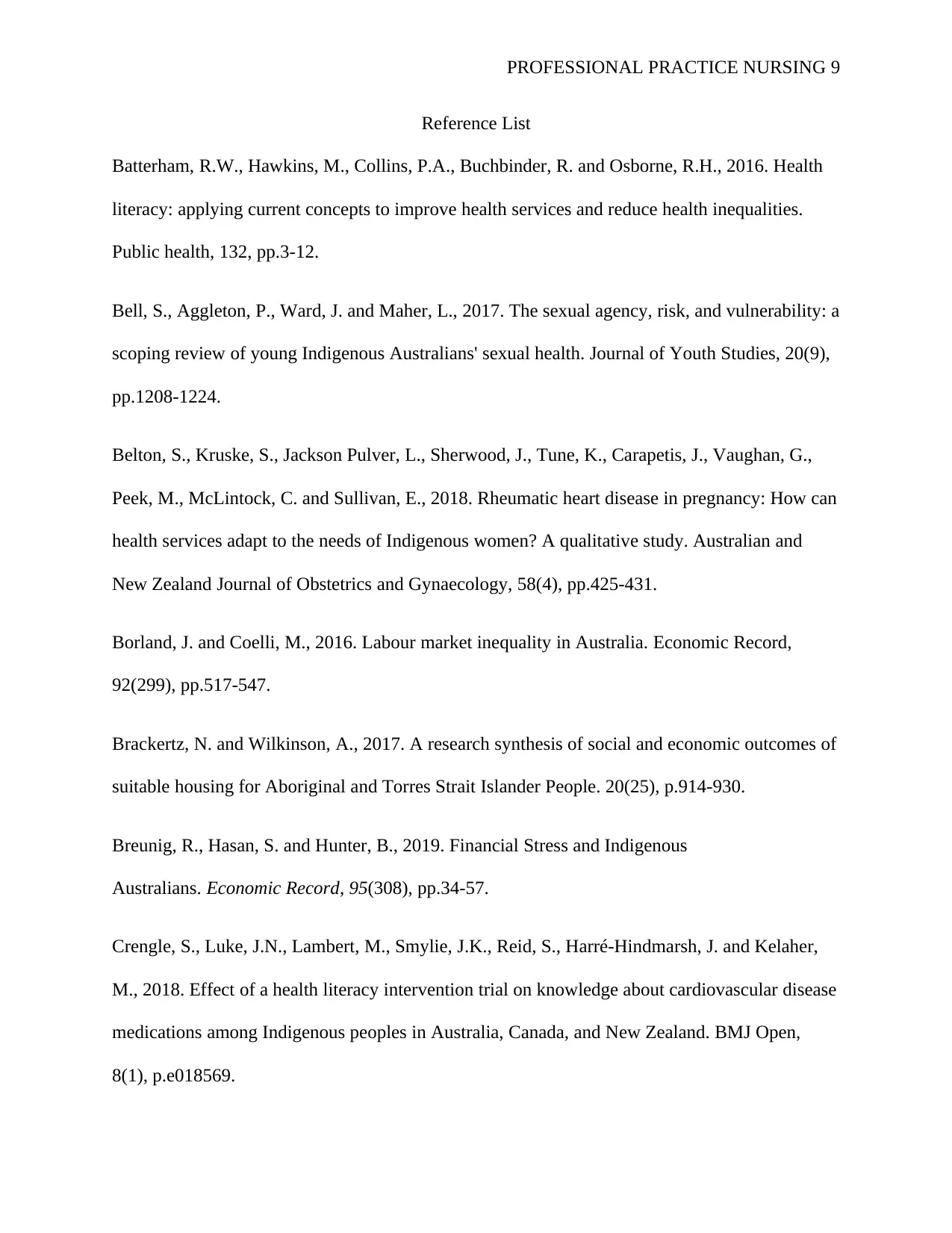
PROFESSIONAL PRACTICE NURSING 9
Reference List
Batterham, R.W., Hawkins, M., Collins, P.A., Buchbinder, R. and Osborne, R.H., 2016. Health
literacy: applying current concepts to improve health services and reduce health inequalities.
Public health, 132, pp.3-12.
Bell, S., Aggleton, P., Ward, J. and Maher, L., 2017. The sexual agency, risk, and vulnerability: a
scoping review of young Indigenous Australians' sexual health. Journal of Youth Studies, 20(9),
pp.1208-1224.
Belton, S., Kruske, S., Jackson Pulver, L., Sherwood, J., Tune, K., Carapetis, J., Vaughan, G.,
Peek, M., McLintock, C. and Sullivan, E., 2018. Rheumatic heart disease in pregnancy: How can
health services adapt to the needs of Indigenous women? A qualitative study. Australian and
New Zealand Journal of Obstetrics and Gynaecology, 58(4), pp.425-431.
Borland, J. and Coelli, M., 2016. Labour market inequality in Australia. Economic Record,
92(299), pp.517-547.
Brackertz, N. and Wilkinson, A., 2017. A research synthesis of social and economic outcomes of
suitable housing for Aboriginal and Torres Strait Islander People. 20(25), p.914-930.
Breunig, R., Hasan, S. and Hunter, B., 2019. Financial Stress and Indigenous
Australians. Economic Record, 95(308), pp.34-57.
Crengle, S., Luke, J.N., Lambert, M., Smylie, J.K., Reid, S., Harré-Hindmarsh, J. and Kelaher,
M., 2018. Effect of a health literacy intervention trial on knowledge about cardiovascular disease
medications among Indigenous peoples in Australia, Canada, and New Zealand. BMJ Open,
8(1), p.e018569.
Reference List
Batterham, R.W., Hawkins, M., Collins, P.A., Buchbinder, R. and Osborne, R.H., 2016. Health
literacy: applying current concepts to improve health services and reduce health inequalities.
Public health, 132, pp.3-12.
Bell, S., Aggleton, P., Ward, J. and Maher, L., 2017. The sexual agency, risk, and vulnerability: a
scoping review of young Indigenous Australians' sexual health. Journal of Youth Studies, 20(9),
pp.1208-1224.
Belton, S., Kruske, S., Jackson Pulver, L., Sherwood, J., Tune, K., Carapetis, J., Vaughan, G.,
Peek, M., McLintock, C. and Sullivan, E., 2018. Rheumatic heart disease in pregnancy: How can
health services adapt to the needs of Indigenous women? A qualitative study. Australian and
New Zealand Journal of Obstetrics and Gynaecology, 58(4), pp.425-431.
Borland, J. and Coelli, M., 2016. Labour market inequality in Australia. Economic Record,
92(299), pp.517-547.
Brackertz, N. and Wilkinson, A., 2017. A research synthesis of social and economic outcomes of
suitable housing for Aboriginal and Torres Strait Islander People. 20(25), p.914-930.
Breunig, R., Hasan, S. and Hunter, B., 2019. Financial Stress and Indigenous
Australians. Economic Record, 95(308), pp.34-57.
Crengle, S., Luke, J.N., Lambert, M., Smylie, J.K., Reid, S., Harré-Hindmarsh, J. and Kelaher,
M., 2018. Effect of a health literacy intervention trial on knowledge about cardiovascular disease
medications among Indigenous peoples in Australia, Canada, and New Zealand. BMJ Open,
8(1), p.e018569.
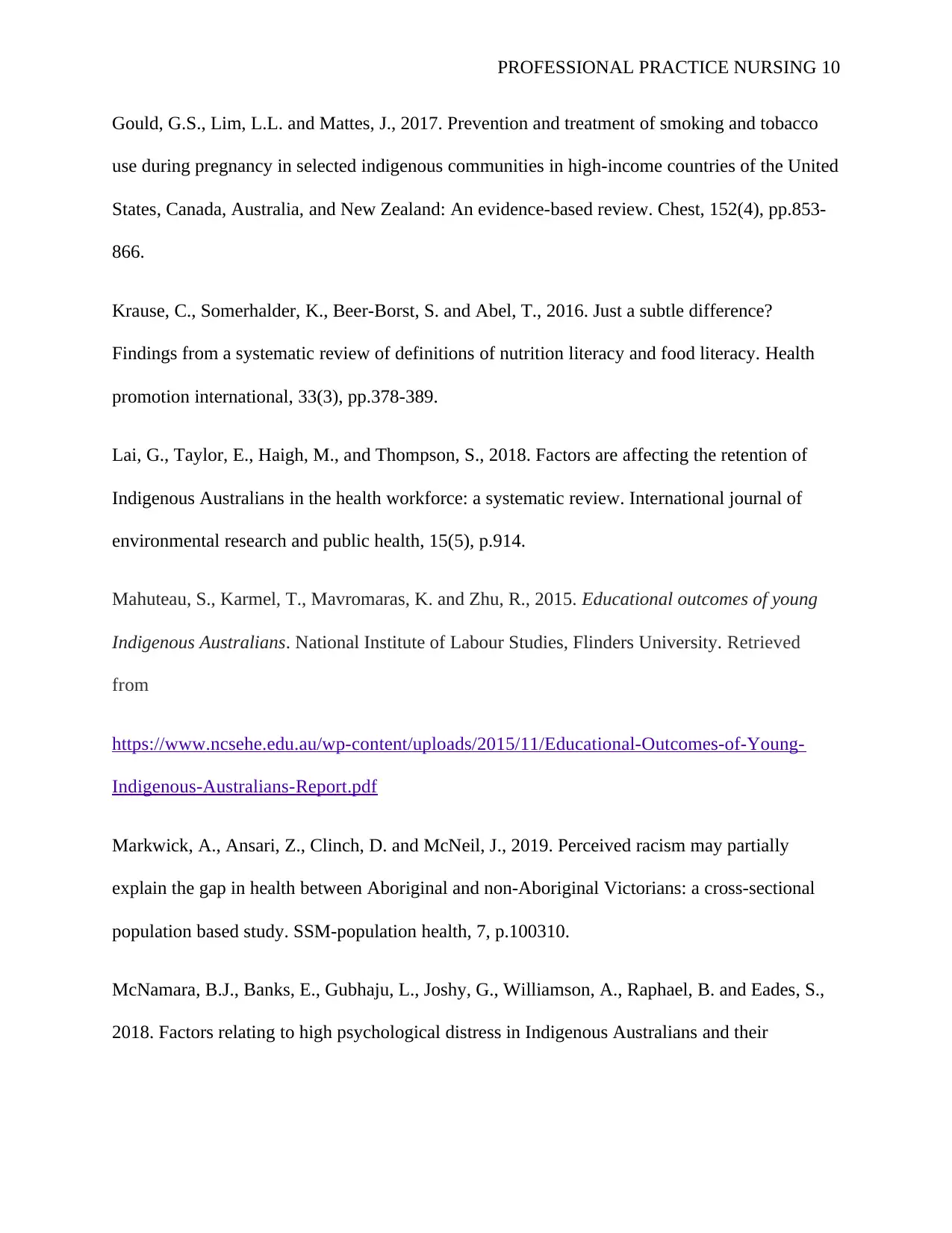
PROFESSIONAL PRACTICE NURSING 10
Gould, G.S., Lim, L.L. and Mattes, J., 2017. Prevention and treatment of smoking and tobacco
use during pregnancy in selected indigenous communities in high-income countries of the United
States, Canada, Australia, and New Zealand: An evidence-based review. Chest, 152(4), pp.853-
866.
Krause, C., Somerhalder, K., Beer-Borst, S. and Abel, T., 2016. Just a subtle difference?
Findings from a systematic review of definitions of nutrition literacy and food literacy. Health
promotion international, 33(3), pp.378-389.
Lai, G., Taylor, E., Haigh, M., and Thompson, S., 2018. Factors are affecting the retention of
Indigenous Australians in the health workforce: a systematic review. International journal of
environmental research and public health, 15(5), p.914.
Mahuteau, S., Karmel, T., Mavromaras, K. and Zhu, R., 2015. Educational outcomes of young
Indigenous Australians. National Institute of Labour Studies, Flinders University. Retrieved
from
https://www.ncsehe.edu.au/wp-content/uploads/2015/11/Educational-Outcomes-of-Young-
Indigenous-Australians-Report.pdf
Markwick, A., Ansari, Z., Clinch, D. and McNeil, J., 2019. Perceived racism may partially
explain the gap in health between Aboriginal and non-Aboriginal Victorians: a cross-sectional
population based study. SSM-population health, 7, p.100310.
McNamara, B.J., Banks, E., Gubhaju, L., Joshy, G., Williamson, A., Raphael, B. and Eades, S.,
2018. Factors relating to high psychological distress in Indigenous Australians and their
Gould, G.S., Lim, L.L. and Mattes, J., 2017. Prevention and treatment of smoking and tobacco
use during pregnancy in selected indigenous communities in high-income countries of the United
States, Canada, Australia, and New Zealand: An evidence-based review. Chest, 152(4), pp.853-
866.
Krause, C., Somerhalder, K., Beer-Borst, S. and Abel, T., 2016. Just a subtle difference?
Findings from a systematic review of definitions of nutrition literacy and food literacy. Health
promotion international, 33(3), pp.378-389.
Lai, G., Taylor, E., Haigh, M., and Thompson, S., 2018. Factors are affecting the retention of
Indigenous Australians in the health workforce: a systematic review. International journal of
environmental research and public health, 15(5), p.914.
Mahuteau, S., Karmel, T., Mavromaras, K. and Zhu, R., 2015. Educational outcomes of young
Indigenous Australians. National Institute of Labour Studies, Flinders University. Retrieved
from
https://www.ncsehe.edu.au/wp-content/uploads/2015/11/Educational-Outcomes-of-Young-
Indigenous-Australians-Report.pdf
Markwick, A., Ansari, Z., Clinch, D. and McNeil, J., 2019. Perceived racism may partially
explain the gap in health between Aboriginal and non-Aboriginal Victorians: a cross-sectional
population based study. SSM-population health, 7, p.100310.
McNamara, B.J., Banks, E., Gubhaju, L., Joshy, G., Williamson, A., Raphael, B. and Eades, S.,
2018. Factors relating to high psychological distress in Indigenous Australians and their
Secure Best Marks with AI Grader
Need help grading? Try our AI Grader for instant feedback on your assignments.
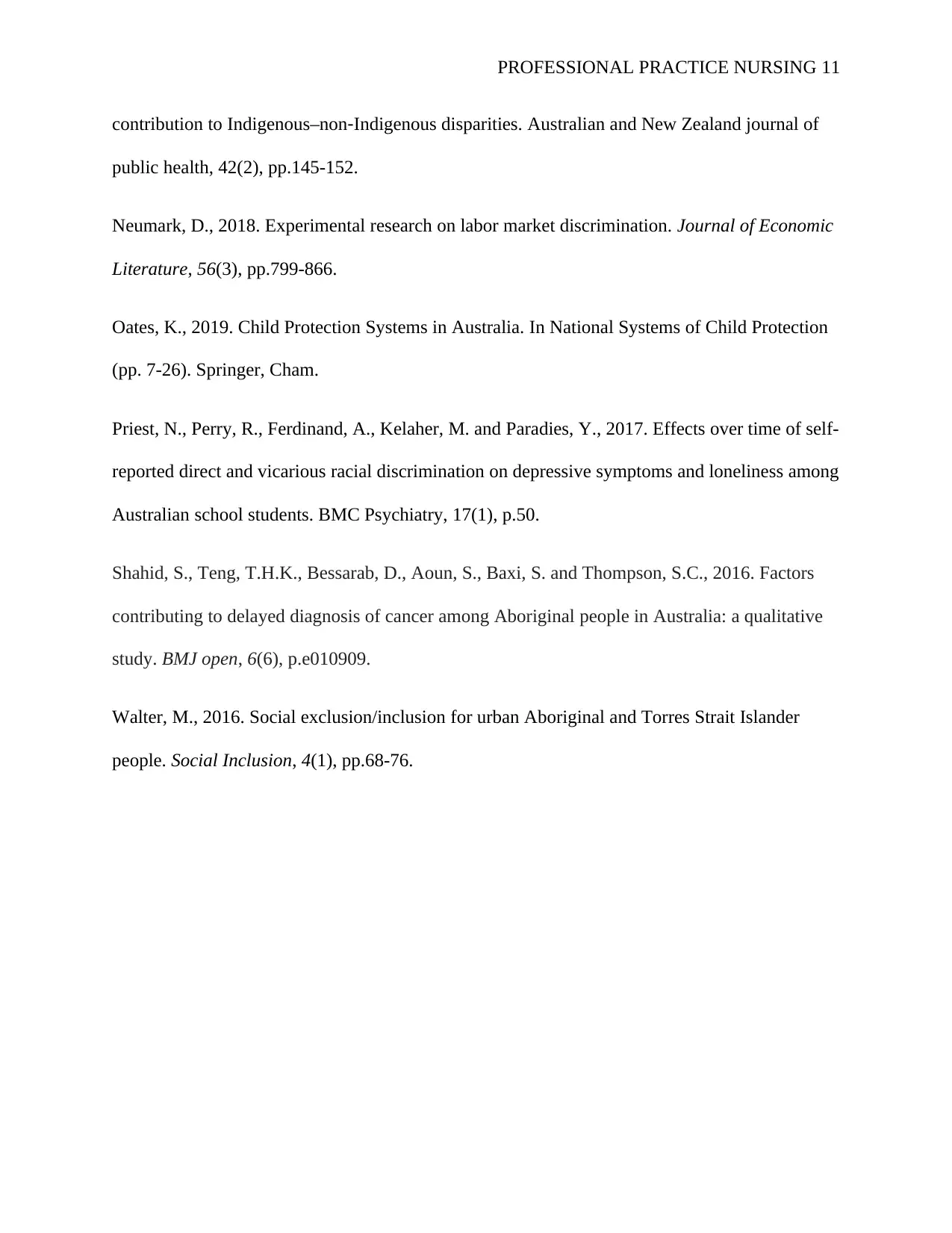
PROFESSIONAL PRACTICE NURSING 11
contribution to Indigenous–non‐Indigenous disparities. Australian and New Zealand journal of
public health, 42(2), pp.145-152.
Neumark, D., 2018. Experimental research on labor market discrimination. Journal of Economic
Literature, 56(3), pp.799-866.
Oates, K., 2019. Child Protection Systems in Australia. In National Systems of Child Protection
(pp. 7-26). Springer, Cham.
Priest, N., Perry, R., Ferdinand, A., Kelaher, M. and Paradies, Y., 2017. Effects over time of self-
reported direct and vicarious racial discrimination on depressive symptoms and loneliness among
Australian school students. BMC Psychiatry, 17(1), p.50.
Shahid, S., Teng, T.H.K., Bessarab, D., Aoun, S., Baxi, S. and Thompson, S.C., 2016. Factors
contributing to delayed diagnosis of cancer among Aboriginal people in Australia: a qualitative
study. BMJ open, 6(6), p.e010909.
Walter, M., 2016. Social exclusion/inclusion for urban Aboriginal and Torres Strait Islander
people. Social Inclusion, 4(1), pp.68-76.
contribution to Indigenous–non‐Indigenous disparities. Australian and New Zealand journal of
public health, 42(2), pp.145-152.
Neumark, D., 2018. Experimental research on labor market discrimination. Journal of Economic
Literature, 56(3), pp.799-866.
Oates, K., 2019. Child Protection Systems in Australia. In National Systems of Child Protection
(pp. 7-26). Springer, Cham.
Priest, N., Perry, R., Ferdinand, A., Kelaher, M. and Paradies, Y., 2017. Effects over time of self-
reported direct and vicarious racial discrimination on depressive symptoms and loneliness among
Australian school students. BMC Psychiatry, 17(1), p.50.
Shahid, S., Teng, T.H.K., Bessarab, D., Aoun, S., Baxi, S. and Thompson, S.C., 2016. Factors
contributing to delayed diagnosis of cancer among Aboriginal people in Australia: a qualitative
study. BMJ open, 6(6), p.e010909.
Walter, M., 2016. Social exclusion/inclusion for urban Aboriginal and Torres Strait Islander
people. Social Inclusion, 4(1), pp.68-76.
1 out of 11
Related Documents
Your All-in-One AI-Powered Toolkit for Academic Success.
+13062052269
info@desklib.com
Available 24*7 on WhatsApp / Email
![[object Object]](/_next/static/media/star-bottom.7253800d.svg)
Unlock your academic potential
© 2024 | Zucol Services PVT LTD | All rights reserved.




